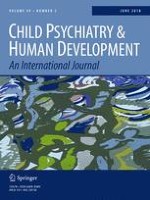08-11-2017 | Original Article
Intergenerational Stability of Callous–Unemotional Traits
Gepubliceerd in: Child Psychiatry & Human Development | Uitgave 3/2018
Log in om toegang te krijgenAbstract
This study investigated the stability of callous and unemotional (CU) traits across generations by assessing self-report assessments of psychopathy factors in parents and their relationship to children’s CU traits in a clinical sample: 223 boys (M age = 7.65) and 83 girls (M = 7.35) referred for treatment of disruptive behavior disorders. First, we expanded previous findings showing a positive relationship between maternal psychopathy scores and CU traits in boys. Second, we tested whether parental psychopathy scores predicted CU traits in children over and above general indicators of mental health risk: parental psychopathology, parental warmth, and harsh parenting. Fathers’ psychopathy factor 1 was uniquely related to CU traits. In contrast, the relationship between mothers’ psychopathy factor 2 and children’s CU traits disappeared when maternal warmth was included. Gender differences suggested these results are most applicable to boys. These findings support the intergenerational stability of psychopathy factor 1 between children and their fathers.
